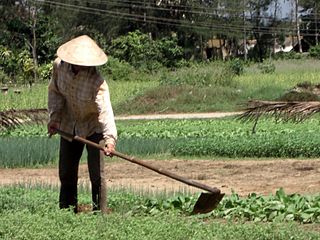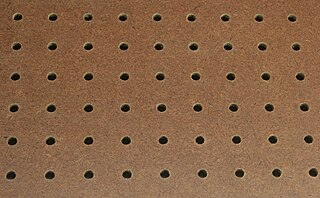
A knife is a tool or weapon with a cutting edge or blade, usually attached to a handle or hilt. One of the earliest tools used by humanity, knives appeared at least 2.5 million years ago, as evidenced by the Oldowan tools. Originally made of wood, bone, and stone, over the centuries, in step with improvements in both metallurgy and manufacturing, knife blades have been made from copper, bronze, iron, steel, ceramic, and titanium. Most modern knives have either fixed or folding blades; blade patterns and styles vary by maker and country of origin.

Alan Fred Titchmarsh HonFSE is an English gardener and broadcaster. After working as a professional gardener and a gardening journalist, he became a writer, and a radio and television presenter.

A hoe is an ancient and versatile agricultural and horticultural hand tool used to shape soil, remove weeds, clear soil, and harvest root crops. Shaping the soil includes piling soil around the base of plants (hilling), digging narrow furrows (drills) and shallow trenches for planting seeds or bulbs. Weeding with a hoe includes agitating the surface of the soil or cutting foliage from roots, and clearing the soil of old roots and crop residues. Hoes for digging and moving soil are used to harvest root crops such as potatoes.

A trowel is a small hand tool used for digging, applying, smoothing, or moving small amounts of viscous or particulate material. Common varieties include the masonry trowel, garden trowel, and float trowel.

A digging stick, sometimes called a yam stick, is a wooden implement used primarily by subsistence-based cultures to dig out underground food such as roots and tubers, tilling the soil, or burrowing animals and anthills. It is a term used in archaeology and anthropology to describe similar implements, which usually consists of little more than a sturdy stick which has been shaped or sharpened and sometimes hardened by being placed temporarily in a fire.

A kunai is a Japanese tool thought to be originally derived from the masonry trowel. The two widely recognized kinds are the short kunai and the big kunai. Although a basic tool, the kunai, in the hands of a martial arts expert, could be used as a multi-functional weapon. The kunai is commonly associated with the ninja, who used it to gouge holes in walls.

A garden fork, spading fork, or digging fork is a gardening implement, with a handle and a square-shouldered head featuring several short, sturdy tines. It is used for loosening, lifting and turning over soil in gardening and farming, and not to be confused with the pitchfork, a similar tined tool used for moving loose materials such as hay, straw, silage, and manure.

A pickaxe, pick-axe, or pick is a generally T-shaped hand tool used for prying. Its head is typically metal, attached perpendicularly to a longer handle, traditionally made of wood, occasionally metal, and increasingly fiberglass.

A rake is a broom for outside use; a horticultural implement consisting of a toothed bar fixed transversely to a handle, or tines fixed to a handle, and used to collect leaves, hay, grass, etc., and in gardening, for loosening the soil, light weeding and levelling, removing dead grass from lawns, and generally for purposes performed in agriculture by the harrow.

A toy wagon has the same structure as the traditional, larger wagon, but is much smaller and has an open top. An average wagon is able to seat one child, and is generally propelled by human power through a handle at the front. Some famous brands are Radio Flyer, Little Tikes, Red Rider, Northern Tool and Equipment, Lowe's, Cardinal, and Speedway Express.

The foot plough is a type of plough used like a spade with the foot in order to cultivate the ground.

Perforated hardboard is tempered hardboard which is pre-drilled with evenly spaced holes. The holes are used to accept pegs or hooks to support various items, and perforated hardboards are therefore used for purposes such as tool boards in workshops. Peg-Board is an expired trademark used as a brand name by the Masonite Corporation, first used in 1962, which is often used as a generic term for perforated storage boards made of hardboard, wood, metal, or other material. It is commonly used in retail settings along with steel rods sticking out to hold peggable products such as bagged potato chips, printer ink, and action figures.
This is an alphabetical index of articles related to gardening.
This glossary of woodworking lists a number of specialized terms and concepts used in woodworking, carpentry, and related disciplines.
A hori-hori, sometimes referred to as a "soil knife" or a "weeding knife", is a heavy serrated multi-purpose steel blade for gardening jobs such as digging or cutting. The blade is sharp on both sides and comes to a semi-sharp point at the end.

An axe is an implement that has been used for millennia to shape, split, and cut wood, to harvest timber, as a weapon, and as a ceremonial or heraldic symbol. The axe has many forms and specialised uses but generally consists of an axe head with a handle, also called a haft or a helve.

A walking stick or walking cane is a device used primarily to aid walking, provide postural stability or support, or assist in maintaining a good posture. Some designs also serve as a fashion accessory, or are used for self-defense.

The British Lawnmower Museum is a museum dedicated to the history of the lawnmowers in Southport, Merseyside, northern England.

Kurung-kurung is a traditional Banjar musical instrument originating from South Kalimantan, Indonesia. Kurung-kurung instrument is made of long wood and the bottom is made of bamboo. This musical instrument can make a sound after being pounded to the ground and the rhythm of the music released will be different from each other, to make a different rhythm, the music player will pound the instrument alternately according to the desired rhythm.


















